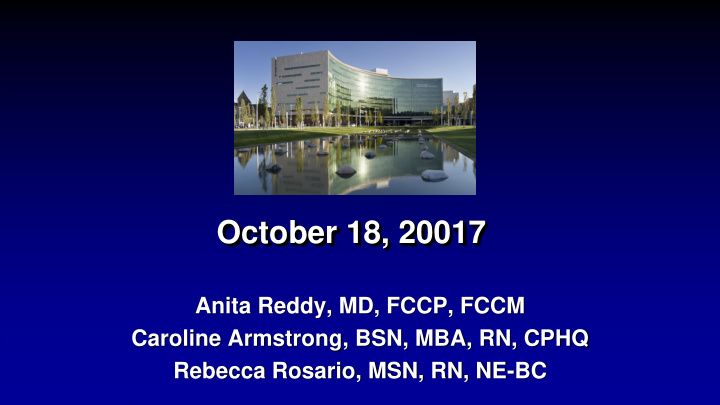



October 18, 20017 Anita Reddy, MD, FCCP, FCCM Caroline Armstrong, BSN, MBA, RN, CPHQ Rebecca Rosario, MSN, RN, NE-BC
Cleveland Clinic Today • 49,000 caregivers • 6.6 million total visits • 164,000 hospital admissions • 3,400 physicians & scientists • 1,888 residents & fellows
10 NEO Regional Hospitals
Cleveland Clinic Locations
Cleveland Clinic Way
ENTERPRISE SEPSIS STEERING COMMITTEE
ESSC • Formed in 2015 • Primary goal: Decrease sepsis-related mortality – 2017: Non-POA mortality – 2018: All mortality • Secondary goal: Increase SEP-1 measure compliance
ESSC Infrastructure Core Team Weekly Meetings Enterprise Measure Quarterly Development Meetings Local Failed Data Sharing Case Reviews Issues Log
ESSC Infrastructure, 2 Core Team Weekly Meetings Enterprise Measure Quarterly Development Meetings Local Failed Case Data Sharing Reviews Issues Log
FAILED CASE REVIEWS
Quality Data Registries • >500 SEP-1 cases reviewed each quarter • 100% IRR • Third review of all OFIs • Team of 5 reviewers • Library of hundreds of questions • Frequent communication with QNET
Failed Case Review
Failed Case Reviews, 2 • Occur at each of our 10 hospitals • Once a month to review all failed cases • Interdisciplinary committee - Physicians - Pharmacy - Lab - Nursing - Quality - Quality Data Registries
Failed Case Review Process • Review of case prior to meeting • Meeting leader familiar with case and able to give background story of patient • Collaboration between ED and Inpatient, Nursing & LIP • ED, Hospitalist and ICU MD presence • Nurse Manager for department with Nursing OFI present • Pharmacy present for clinical expertise and to review process issues with obtaining antibiotics • Lab representation as needed **Interdisciplinary teams allow you to build and diversify your hospital’s SEP experts**
Failed Case Review Results • Record area/department involved - Keep track of order set usage • Identify areas for improvement in processes • Give feedback to those involved via failed case notification letters - Ideally are present during the review or provide feedback on decision making prior to meeting
Failed Case Review Results, 2 • Helps drive process improvement - Antibiotic cards - Changes in order set - Sepsis posters - Sepsis pocket cards for LIPs - Sepsis pocket cards for Nursing - Sepsis education module for Nursing and LIPs
Failed Case Review Challenges • Frequent updates to measure • Varying levels of confidence in the measure • Inability to clearly identify true time zero while caring for patient • Cultural differences within Enterprise hospitals • Education across a health system • Documentation
COLLABORATION WITH MEASURE STEWARDS
Collaboration with Measure Stewards, 2 • Phone conferences regarding SEP-1 measure and opportunities for improvement • Discussion at national meetings • Email communication regarding clinical scenarios and abstraction
SEP-1 Updates – Jan. 2018 • Documentation of ESRD with hemodialysis or peritoneal dialysis excludes elevated creatinine levels. • Documentation of CKD or chronic renal insufficiency with a baseline creatinine will exclude creatinine values up to 0.5 above baseline.
SEP1-Updates • Documentation that patient was given an anticoagulant from approved table of medications excludes elevated INR and aPTT • Fluids given by EMS or in OR can be used without an order. The documentation must include the type of fluid, volume, initiation date/time and rate, duration or end time
ANALYSIS AND PRODUCTIVITY
National Meeting Presence • IRR process - Difficult measure to abstract - Abstraction can vary between individuals • Patients with bundle compliance had a lower mortality • Patients with bundle compliance had a lower risk of readmission
Recommend
More recommend